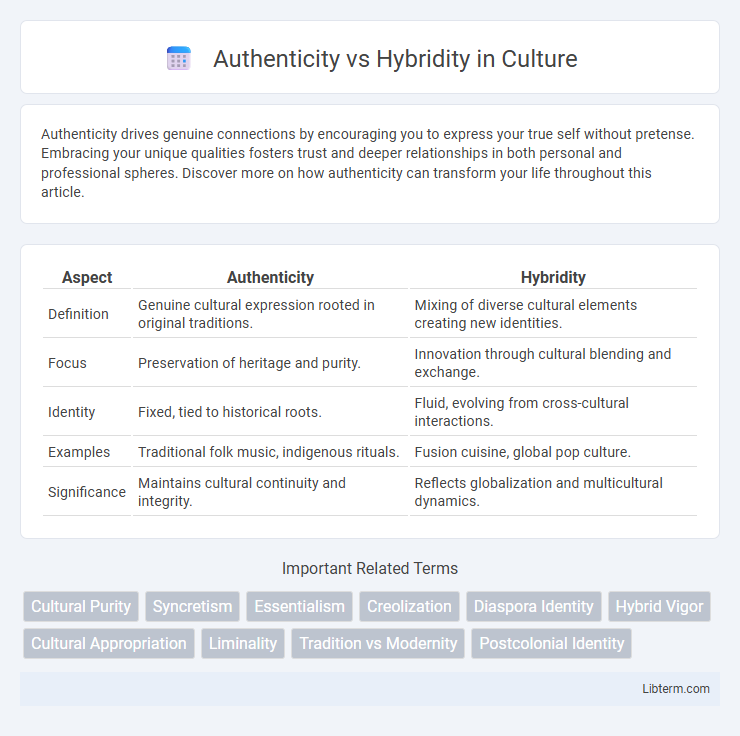Authenticity drives genuine connections by encouraging you to express your true self without pretense. Embracing your unique qualities fosters trust and deeper relationships in both personal and professional spheres. Discover more on how authenticity can transform your life throughout this article.
Table of Comparison
| Aspect | Authenticity | Hybridity |
|---|---|---|
| Definition | Genuine cultural expression rooted in original traditions. | Mixing of diverse cultural elements creating new identities. |
| Focus | Preservation of heritage and purity. | Innovation through cultural blending and exchange. |
| Identity | Fixed, tied to historical roots. | Fluid, evolving from cross-cultural interactions. |
| Examples | Traditional folk music, indigenous rituals. | Fusion cuisine, global pop culture. |
| Significance | Maintains cultural continuity and integrity. | Reflects globalization and multicultural dynamics. |
Defining Authenticity in Contemporary Culture
Authenticity in contemporary culture is often defined by the genuine expression of individual identity and adherence to original cultural practices, resisting commodification and superficial imitation. It emphasizes the value of lived experiences and historical continuity within cultural expressions, distinguishing authentic traditions from hybrid forms that blend or alter original elements. This concept challenges the dilution of cultural meaning in globalized contexts, asserting the importance of preserving core cultural narratives.
Understanding Hybridity: Origins and Evolution
Hybridity originates from postcolonial theory, emphasizing the blending and mixing of cultures resulting from colonization and globalization. It evolves as a dynamic process challenging fixed notions of cultural identity by highlighting the permeability and fluidity of cultural boundaries. This concept underlines that cultural identities are not pure but constantly reshaped through interaction and exchange.
The Tension Between Pure and Mixed Identities
Authenticity and hybridity represent opposing yet intertwined concepts in identity discourse, with authenticity emphasizing pure, unaltered cultural roots and hybridity highlighting the blending of diverse cultural elements. The tension between pure and mixed identities arises as individuals and communities navigate preserving traditional values while adapting to global cultural exchanges, leading to complex negotiations of self-representation. This dynamic challenges rigid notions of identity, promoting a fluid understanding that accommodates both continuity and change within cultural frameworks.
Authenticity vs Hybridity in Art and Literature
Authenticity in art and literature emphasizes originality and faithful representation of cultural or personal identity, often highlighting traditional practices and genuine expressions. Hybridity challenges these notions by blending diverse cultural elements, creating innovative works that reflect complex, cross-cultural identities and global influences. This dynamic tension shapes contemporary creative landscapes, fostering debates on ownership, identity, and the evolving definition of authenticity.
Cultural Purity: Real or Constructed Notion?
Cultural purity often emerges as a constructed notion rather than an authentic reality, influenced by historical exchanges and ongoing globalization that blend traditions and identities. Authenticity in culture is frequently challenged by hybridity, which embraces the fluidity and fusion of diverse cultural elements across time and space. The perception of cultural purity ignores the dynamic, evolving nature of societies shaped by migration, trade, and intercultural dialogue.
Hybrid Influences in Globalized Societies
Hybrid influences in globalized societies shape cultural identities by blending traditional elements with external innovations, creating dynamic and fluid expressions of authenticity. These hybrid forms challenge rigid notions of purity, emphasizing the interconnectedness of global cultures through shared practices, languages, and symbols. The continuous exchange of cultural traits fosters pluralism, enabling individuals to navigate multiple identities and meanings within diverse social contexts.
Navigating Identity: Choosing Between Roots and Fusion
Navigating identity involves balancing authenticity, rooted in cultural heritage, with hybridity, which embraces fusion and adaptation across diverse influences. Individuals often face the challenge of honoring ancestral traditions while integrating new cultural elements to form a dynamic, evolving sense of self. This interplay shapes personal and collective identities in globalized societies, highlighting the tension between preserving origins and embracing multicultural transformation.
The Role of Media in Shaping Authentic and Hybrid Narratives
Media platforms significantly influence the construction of authenticity and hybridity by selectively portraying cultural identities through curated content and representation. Mass media often reinforces traditional notions of authenticity by highlighting perceived "pure" cultural elements, while social media fosters hybrid narratives by allowing diverse voices to blend and reinterpret cultural symbols. These mediated narratives shape public perception by either preserving cultural integrity or promoting dynamic, hybrid cultural expressions.
Authenticity and Hybridity in Personal Branding
Authenticity in personal branding emphasizes genuine self-representation and consistency in values, voice, and actions, which builds trust and long-term connections with the audience. Hybridity in personal branding blends diverse influences, cultures, and skills to create a unique and adaptable identity that resonates across multiple contexts. Balancing authenticity with hybridity enables individuals to maintain core integrity while embracing innovation and diversity, enhancing personal and professional appeal.
Future Perspectives: Embracing Complexity in Identity
Future perspectives on identity emphasize embracing complexity through the integration of authenticity and hybridity, recognizing fluid, multifaceted self-representations as integral to personal and cultural narratives. Embracing hybridity allows individuals to navigate multiple cultural influences, fostering innovation and adaptability in a globalized world. Authenticity evolves as a dynamic construct, reflecting diverse experiences and resisting rigid categorizations for a more inclusive understanding of identity.
Authenticity Infographic

 libterm.com
libterm.com